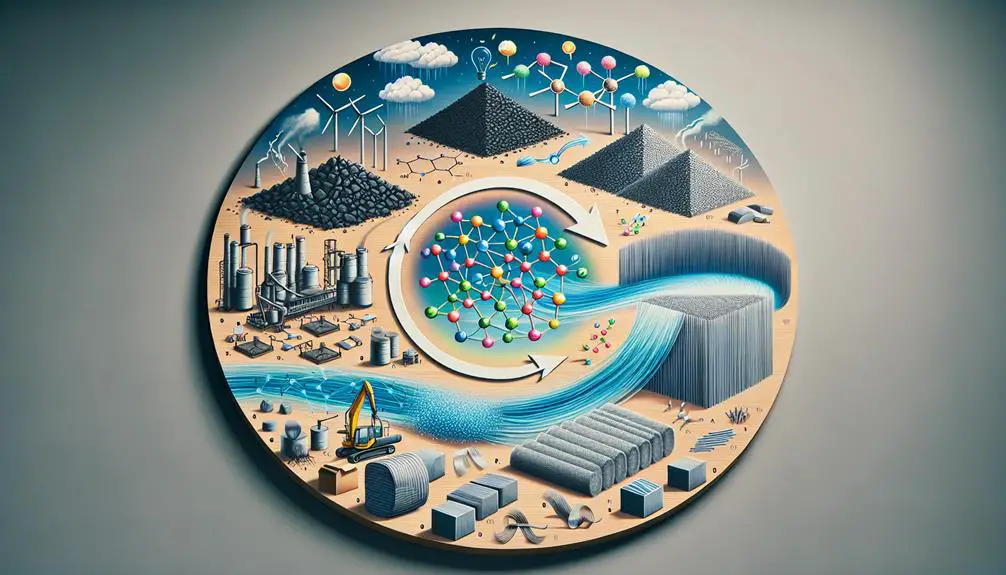Nylon fabric is made from synthetic polymers, specifically designed for their strength and flexibility. It all starts by combining certain chemicals like hexamethylenediamine and adipic acid, which form a nylon salt. This mixture then undergoes polymerization, transforming into long, chain-like molecules. These are extruded through a spinneret to create the actual fibers. The fibers are then stretched to align the molecules, which significantly enhances their strength and durability. And there's more to nylon's story that just might intrigue you further!
Table of Contents
Key Takeaways
- Nylon fabric is made from synthetic polymers with amide linkages.
- It involves polymerization of diamines and dicarboxylic acids or aminocarboxylic acids.
- The process starts with creating nylon salt from hexamethylenediamine and adipic acid.
- Molten nylon is extruded through a spinneret to form fibers.
- These fibers are stretched to align molecules, enhancing strength and durability.
History of Nylon
Nylon fabric, invented by Wallace Carothers at DuPont in 1935, truly revolutionized the textile industry. Before nylon, DuPont was already dabbling with cellulose-based fibers, much like rayon. However, nylon was a game-changer, marking a significant leap in synthetic fiber production.
The journey to nylon began with the synthesis of nylon salt, a critical compound derived through complex chemical reactions. This was a novel approach back then, setting the stage for creating fibers with unparalleled strength and elasticity. Its thermoplastic nature meant that nylon could be melted and remolded without altering its inherent properties, opening up endless possibilities for industrial applications.
What's fascinating is how quickly nylon found its way into various products. Initially used in toothbrush bristles, its potential soon became apparent, paving the way for broader uses, particularly in the textile industry. Its introduction offered a durable, moldable, and more efficient alternative to traditional fibers.
Understanding the history of nylon, from its conceptualization at DuPont by Wallace Carothers to its widespread adoption, highlights the innovative spirit and the drive toward synthetic alternatives that characterized the early 20th-century industrial landscape. The move from natural to synthetic materials wasn't just about innovation; it was a necessary evolution in material science.
Chemical Composition
Delving into its chemical makeup, we find that nylon fabric is crafted from synthetic polymers featuring amide linkages between aliphatic or semi-aromatic units. The unique chemical composition of nylon not only defines its properties but also distinguishes it from other synthetic fabrics.
Here's a breakdown of the chemical components and their roles:
- Diamines and Dicarboxylic Acids: These are the backbone of the most common types of nylon, like nylon-6,6. They react through a condensation polymerization process, resulting in strong polyamide chains.
- Aminocarboxylic Acids: Used primarily in the production of nylon-6, these acids simplify the polymerization process by combining the amine and acid groups into a single monomer unit.
- Polymerization Process: The reaction between diamines and dicarboxylic acids, or the self-condensation of aminocarboxylic acids, creates long chains of polyamide molecules. This step is crucial for developing nylon's inherent strength and durability.
- Amide Linkages: These linkages are responsible for the high melting point and resistance to abrasion, which are signature characteristics of nylon fabric.
Understanding the chemical composition of nylon helps us appreciate why it's so widely used in various applications, providing strength, durability, and flexibility where needed.
Types of Nylon
Moving on to the types of nylon, it's fascinating to see how different varieties are designed for specific purposes.
For instance, Nylon 6,6 is a go-to for waterproof items like swimwear, while Nylon 6 shines in making tough, lightweight activewear.
Each type of nylon brings something unique to the table, tailored to enhance performance in its intended application.
Nylon Production Varieties
Let's explore the different types of nylon used in fabric production, each offering unique characteristics and benefits. Delving into these varieties helps us understand why certain nylons are chosen for specific products.
- Nylon 6,6: This type is celebrated for its waterproof properties and durability, making it ideal for swimwear and outdoor gear. Its production involves a specific polymerization process that enhances these traits.
- Nylon 6: Known for being tough yet lightweight, this polymer is perfect for activewear and bags, providing essential strength and flexibility.
- Nylon 4,6: With superior strength, heat, and chemical resistance, this synthetic fiber is used in manufacturing car parts and safety gear.
- Nylon 510: This variant, derived from pentamethylene diamine and sebacic acid, is tailored for industrial and scientific applications due to its unique properties.
Common Nylon Applications
Nylon's versatility shines through its widespread use in everything from clothing to automotive parts. The various applications of nylon cater to specific needs across industries.
For instance, Nylon 6,6, known for its high strength and toughness, is perfect for wear pads and bearings in industrial machinery. Automotive components often utilize Nylon 4,6 due to its superior chemical resistance and heat tolerance, making it ideal for under-the-hood parts. Meanwhile, Nylon 510, though pricier, finds its niche in high-end industrial and scientific applications because of its unique properties.
Even in the medical field, nylon's adaptability is evident as it's used in numerous medical devices, highlighting its critical role across different sectors.
Production Process
The process of making nylon begins by combining hexamethylenediamine with adipic acid to create a nylon salt precursor. This combination is crucial in the production process, setting the stage for the creation of those strong, versatile fibers we see in everything from stockings to car parts.
Let me break down the steps that transform these raw materials into the nylon fabric:
- Polymerization: The nylon salt undergoes polymerization, where it's heated and transformed into long, chain-like molecules. This step is essential for developing the base material that will eventually become nylon fibers.
- Extrusion through Spinneret: This polymer is then forced through a spinneret, a tool somewhat similar to a showerhead but with much finer holes, to form thin streams of molten nylon. As it exits the spinneret, the nylon begins to cool down and solidify into fibers.
- Stretching for Strength: Post-extrusion, these fibers aren't quite done yet. They're stretched, often multiple times their original length. This aligns the molecules within the fibers, massively enhancing their strength and durability.
- Winding: Finally, the stretched fibers are wound onto bobbins, ready to be woven into fabrics or used in other applications.
Each step is designed to ensure the nylon's durability and performance, making it a powerhouse in the textile industry.
Properties of Nylon
Exploring nylon fabric, we find it's not only strong and durable but also resistant to moisture and abrasion. Derived from polyamide polymers, this fabric has a reputation for its impressive durability and resistance to abrasion, making it a reliable material in various applications. It's fascinating to see how these characteristics come from the very nature of the polymers used.
Nylon is incredibly lightweight, which adds to its appeal. The moisture resistance is another standout feature, ensuring that the fabric remains dry and comfortable under various conditions. This combination of properties makes it a versatile choice for many.
Below, I've put together a quick table comparing the properties of two common types of nylon, Nylon 6,6 and Nylon 6, to help you understand the subtle differences that impact their use:
| Property | Nylon 6,6 | Nylon 6 |
|---|---|---|
| Strength | High | Moderate to High |
| Durability | Very High | High |
| Moisture Resistance | Excellent | Good |
Both types of nylon offer unique advantages depending on the specific needs. Whether you're looking for something exceptionally durable or need a fabric that balances strength and flexibility, there's a nylon type that fits the bill.
Common Uses
Nylon's versatility really shines when you look at how it's used across different industries.
From clothing like swimwear and lingerie that benefit from its stretch and durability, to tough settings like industrial conveyor belts and safety gear, it's everywhere.
We'll also see how it plays a big role in home decor, making items like sofas and carpets last longer.
Clothing and Apparel Applications
One often finds nylon fabric in everyday clothing items like swimwear and sportswear because it's both durable and stretchy. Here's a breakdown of its key uses in apparel:
- Swimwear and Sportswear: Nylon's elasticity makes it perfect for these items, as it allows for extensive movement and comfort during physical activities.
- Hosiery and Lingerie: The fabric's smooth texture and stretchability provide an ideal fit and durability, key for undergarments that require flexibility and strength.
- Outdoor Gear: While primarily for clothing, its use in items like backpacks showcases nylon's versatility in apparel-related accessories.
- Upholstery: In home settings, nylon's durability translates into long-lasting furniture coverings, though not directly worn.
Nylon fabric thus supports a wide range of applications within the clothing and apparel sector.
Industrial and Automotive Roles
While we've seen nylon's versatility in clothing, it also plays a significant role in industrial and automotive applications. In the manufacturing process, nylon fibers are essential for their strength and durability, making them ideal for conveyor belts, ropes, and safety harnesses in industrial settings. This resilience ensures reliability under harsh conditions, which is crucial for industrial machinery.
Nylon's adaptability extends to the automotive industry, where its resistance to heat and chemicals makes it perfect for components like gears and bearings. This versatility means it's not just about what nylon can handle in terms of wear and tear; it's also about safety and efficiency in production and operation, highlighting why nylon is so valued in these demanding environments.
Home Decor Possibilities
Shifting focus to the home, nylon fabric offers endless possibilities in decor, from durable curtains to stylish table runners. Its incredible durability and resistance to abrasion make it ideal for various applications. Here's a quick rundown:
- Rugs and Carpets: Perfect for high-traffic areas because of their tough nature, ensuring longevity and maintaining appearance.
- Decorative Throw Pillows: Thanks to its colorfastness, the vibrant colors of these pillows won't fade quickly.
- Draperies and Blinds: Nylon's ability to resist wrinkles and maintain shape makes it a top choice for window treatments.
- Upholstery: It stands up to daily wear and tear, keeping furniture looking fresh and inviting.
Nylon truly transforms any space with style and functionality.
Environmental Impact
Nylon's production process, reliant on crude oil, significantly harms the environment through energy consumption and pollution. As one of the synthetic fabrics derived from non-renewable raw materials, its production isn't just a hefty consumer of energy but also a major polluter. The process emits nitrous oxide, a potent greenhouse gas that's way worse for our climate than carbon dioxide. Plus, it leads to acid rain and significant water pollution, adding layers to its environmental impact.
The troubles don't stop after nylon's made. It's non-biodegradable, meaning it doesn't just disappear after you toss it. Instead, it sits around in landfills for hundreds of years. This persistence in the environment makes its disposal a critical issue. Although recycling could theoretically cut down on the waste, the recycling of nylon is complex due to its chemical structure.
Recycling and Sustainability
As we look at nylon's potential for sustainability, it's clear that recycling processes are key. However, these processes pose their own challenges due to the high energy required.
On a brighter note, eco-friendly alternatives like Econyl show we can make a difference by turning waste back into wearable fabrics.
Nylon Recycling Processes
Many discarded nylon products, like fishing nets and carpet fibers, undergo a recycling process to transform them into new, usable materials. Here's how it typically goes down:
- Collection: Collected nylon waste includes items like old fishing nets or worn-out carpets.
- Cleaning and Shredding: This waste is then cleaned thoroughly and shredded into smaller pieces.
- Pellet Formation: These pieces are processed into recycled nylon pellets, ready for a new life.
- Manufacturing: Brands like Econyl use these pellets to create products ranging from clothing to accessories.
Recycling nylon not only reduces waste but also cuts down on the environmental impact of fresh nylon production. It's a solid step towards sustainability, keeping post-consumer waste out of landfills and conserving valuable resources.
Sustainability Challenges
Despite its usefulness, nylon fabric presents significant sustainability challenges due to its environmental impact and complex recycling process. Nylon's non-biodegradable nature means we've got to think hard about disposal and recycling options. Recycling it isn't a walk in the park either—it's energy-intensive and contributes further to environmental degradation. Plus, the production of nylon fabric releases nitrous oxide, a real troublemaker for our climate.
| Challenge | Detail |
|---|---|
| Non-biodegradable | Difficult to dispose, persists in nature |
| Recycling Complexity | Energy-intensive, costly |
| Nitrous Oxide Emission | Contributes to greenhouse gas emissions |
We're exploring sustainable practices and innovations like Econyl to tackle these issues, but there's a long road ahead.
Eco-Friendly Alternatives
Exploring eco-friendly alternatives like Econyl is key to addressing the sustainability challenges posed by traditional nylon production. Here's why opting for recycled nylon like Econyl matters:
- Reduces virgin nylon production: By using regenerated waste materials, we cut down on the energy-intensive process required for creating new nylon.
- Infinite recycling: Nylon's ability to maintain quality through multiple recycling rounds means less waste.
- Supports circular fashion industry: Incorporating Econyl promotes eco-friendly practices and propels the industry towards sustainability.
- Environmental impact: Though recycling is energy-intensive, it's a greener option compared to producing virgin nylon.
I'm all for pushing forward the sustainable agenda and seeing more brands embrace these practices.
Certifications and Standards
To ensure safety and sustainability, nylon fabrics often undergo rigorous certifications and meet strict standards. For instance, the Global Recycled Standard (GRS) is key when dealing with recycled nylon fabrics. This certification assures that the materials not only come from recycled sources but also meet crucial environmental and social criteria throughout their production.
Moreover, when checking for fabric safety, the Oeko-Tex certification is a go-to. It guarantees that the nylon fabric is free from harmful substances, ensuring it's safe for human use. This assurance is especially important when selecting fabrics for clothing and home textiles.
For a deeper dive into environmental care, Bluesign certification is essential. It focuses on sustainable production processes, significantly reducing the negative impacts on our planet. Likewise, the Cradle to Cradle Certified mark indicates that the nylon fabric is designed with future life cycles in mind, promoting recyclability and overall environmental responsibility.
Lastly, adhering to ISO 9001 standards is crucial for maintaining a robust quality management system in the production of nylon fabrics. It helps ensure that every piece of fabric meets high-quality benchmarks, which is critical for both consumer satisfaction and brand reputation.
Market Trends
After looking at how nylon fabrics are certified for safety and sustainability, let's see how these factors are influencing the latest market trends. The global market for nylon fabric is booming, and here's why:
- Global Reach: Expected to surpass $30 billion by 2026, the demand for durable and versatile synthetic fibers is skyrocketing, particularly in booming economies like China and India.
- Automotive Demand: The automotive industry heavily relies on nylon for making everything from airbags to engine parts. This sector's growth directly boosts the need for high-quality nylon fabric.
- Sustainable Shifts: There's a significant pivot towards sustainable production within the textile industry. Innovations like recycled nylon aren't just buzzwords but are shaping buyer preferences and manufacturing practices.
- Diverse Applications: Beyond traditional textiles, nylon's versatility is being tapped into industries such as healthcare and electronics, expanding its market presence and utility.
These trends show how the interplay between sustainability and innovation isn't just driving but revolutionizing the market for synthetic fibers like nylon. As the demand continues to evolve, so does the approach to producing and utilizing nylon fabric, ensuring its place in the future of textiles and beyond.
Innovations in Nylon Technology
Recent innovations in nylon technology have revolutionized the fabric's sustainability and functionality. I've noticed that the introduction of eco-friendly recycled nylon fabrics, like Econyl, is a game changer. These materials aren't just good for the planet; they maintain the strength and durability we've always valued in traditional nylon. The advanced techniques in nylon production have significantly boosted these traits, making the fabric even more versatile than before.
The push towards enhancing sustainability is evident. Researchers are tweaking every aspect of production to lessen the environmental impact. For instance, the new dyeing processes they've developed are fascinating. These methods not only improve the color vibrancy and fastness of nylon but also adhere to eco-friendly practices. It's all about getting that perfect color without dumping harmful chemicals into our ecosystems.
Plus, there's a buzz around using nanotechnology in nylon fabrics. This isn't just about making the material tougher; it's about adding functional features like water repellency, UV resistance, and antimicrobial properties. This level of innovation ensures that nylon isn't just a fabric; it's a cutting-edge solution for modern needs. As someone keen on both technology and sustainability, I find these advancements incredibly promising.
Future Prospects
Building on these advancements, the future of nylon fabric looks promising as we explore even more sustainable and innovative applications. The shift towards using recycled nylon materials like Econyl is gaining traction, reflecting a broader commitment to sustainability and addressing key environmental concerns. Here's what I'm excited about:
- Expansion of Recycled Materials: More companies are investing in technologies to create high-quality recycled nylon, reducing waste and energy consumption.
- Integration with Natural Fabrics: By combining nylon with natural fibers, such as organic cotton, we can achieve textiles that are both durable and environmentally friendly.
- Advancements in Ripstop Nylon: The development of enhanced ripstop nylon fabric can revolutionize outdoor and sports gear by improving performance while still prioritizing safety concerns.
- Focus on Safety and Health: As awareness of potential health risks grows, there's a push to develop nylon fabrics free from toxic chemicals and BPA, ensuring safer products for consumers and the planet.
These developments not only promise to make nylon more sustainable but also aim to maintain the high performance standards we've come to expect. It's a thrilling time to be involved in textile innovation, focusing on both environmental integrity and consumer safety.
Frequently Asked Questions
Is Nylon a Good Fabric?
Yes, I think nylon is a great fabric because it's strong, durable, and resists moisture, making it ideal for sportswear and outdoor gear. It's also lightweight and versatile, which adds to its appeal.
Is Nylon a Polyester or Cotton?
Nylon isn't polyester or cotton; it's a distinct synthetic polymer known as polyamide, derived from petrochemicals, offering unique properties compared to naturally occurring fibers or other synthetics like polyester.
What Are the Disadvantages of Nylon Fabric?
I've noticed nylon fabric absorbs moisture, fades under UV light, and can't handle high heat. It's also not biodegradable and shrinks with heat, which makes maintenance a bit tricky.
Is Nylon 100% Plastic?
No, nylon isn't 100% plastic; it's a type of polyamide, which is a specific category of plastic polymer. It's known for its strength and used widely in many different products.
- The Use of Nonwovens in Construction and Civil Engineering - July 11, 2025
- The Use of Nonwovens in Construction and Civil Engineering - July 11, 2025
- The Use of Nonwovens in Construction and Civil Engineering - July 11, 2025







